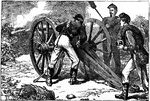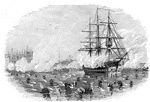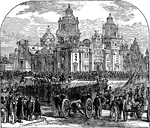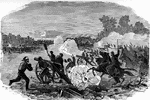
Driggs-Shroeder 6-Pounder
"Ordinance is military guns of the larger class; artillery; also called rifles, guns, or cannon."—(Charles…

Battle of Atlanta
Showing the Battle for Atlanta, which Sherman won for the Union during the Civil War.
Gravitational Attraction
"Two cannon balls, when suspened by long cords, so as to hang quite near each other, are found to exert…

Bouquet Battery
"The Bouquet Battery, commanding the viaduct over the Patapsco River, on the Baltimore and Ohio Railroad,…

Cannon used at the time of the American Revolution
Cannon used at the time of the American revolution

Captain Standing on Cannon with Foot on Railing of Ship
An illustration of a captain standing on a cannon with his foot on the railing of the ship.

Centrifugal Force
"Suppose a cannon ball, tied with a string to the centre of a slab of smooth marble, and suppose an…

Valley of Chickahominy
"Valley of the Chickahominy, looking southeast from the vicinity of Mechanicsville, the scene of the…

Valley of Chickahominy
"Valley of the Chickahominy, looking southeast from the vicinity of Mechanicsville, the scene of the…

Valley of Chickahominy
"Valley of the Chickahominy, looking southeast from the vicinity of Mechanicsville, the scene of the…

Valley of Chickahominy
"Valley of the Chickahominy, looking southeast from the vicinity of Mechanicsville, the scene of the…

Shelling of Confederate Camp
"Shelling of a Confederate camp on the Potomac by Lieutenant Tompkins, of the First Rhode Island battery.…

Bombardment of Fort Sumter, April 12, 1861
Confederate forces bombarding Fort Sumter on April 12, 1861

Freire Gas Check
"A device for preventing the escape of gas through the vent or around the breech-mechanism which closes…
Gravity Proved by Cannon Balls
"That the cannon ball is capable of attracting as well as being attracted, may be proved by suspending…

Great Falls
"Shelling Confederate cavalry across the Potomac River from the heights of Great Falls, by Major West,…

Noiseless and Flashless Gun
"Ordinance is military guns of the larger class; artillery; also called rifles, guns, or cannon."—(Charles…

Horse
A horse, with names of parts. 1, crest; 2, withers; 3, croup; 4, hamstring; 5, hock; 6, cannon; 7, fetlock;…

Man Holding Linstock Peers through an Embrasure
A man holding a smoldering slow match on a linstock leans over a cannon to look through an embrasure.

Gaine's Mill
Soldiers capturing a cannon. Depiction of the Battle of Gaine's Mill during the Civil War. It was the…

Thirteen-inch Shell Mortar Practice
"Mortar practice- 13-inch shell mortar, as used by the Federal government- weight of mortar 17,000 pounds."…

Mortar Practice - Rear View
"Mortar practice- rear view of 13-inch mortar, with its usual complement of seven gunners. The mortar…

240 mm Trench Mortar
An illustration of a 240 mm Trench Mortar used by the French during World War I, and designed by Dumezil—Batignolles.…

Barrel View of Stokes Mortar
An schematic illustration of the 3 inch Stokes mortar. The mortar is made out of steel and screwed onto…

Rifled Carriage Light Minenwerfer Mortar
A light carriage minenwerfer class mortar used for direct fire. The barrel and the shifting lever is…

Front View of Stokes Mortar with Bipod
The illustration shows a schematic view of the Stokes Mortar being mounted onto the bipod. The mortar…

Rifled Heavy Minenwerfer Mortar
An illustration showing the German minenwerfer, or mine launcher, class for short range mortars. The…
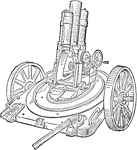
Rifled Light Minenwerfer Mortar
A light minenwerfer with 7.6 cm caliber designed by German during World War I. The series of gears adjusts…

Rifled Medium Trench Mortar
The illustration of a medium trench mortar used during World War I. The mortar was designed with a rifled…

Mounted Steel Mortar
"The mortar is a stout cannon of forged steel with simple vent firing and rear trunnions. The maximum…

Ballistic Pendulum
"From a cross piece, A, on a stout framework, a heavy block of wood, B, is suspended, in such a way…

Battle of Pittsburg Landing
Recapture of artillery by the First Ohio and other regiments under General Rousseau, April 7, 1862.…

Battle at Potomac
"Engagement between the Federal troops and the Confederates on the Virginia side of the Potomac, opposite…

Projectile Motion of a Cannonball
"Suppose a cannon be loaded with a ball, and placed on top of a tower, at such a height from the ground,…

Projectile Motion of a Cannon Ball
"Thus, we have a cannon planted on a towwer at such a height that it would take four seconds for a ball…
192 Pound Trench Mortar Bomb Shell
A 192 pound bomb shell for the 240 mm trench mortar used during World War I. The vanes, or wings, are…





